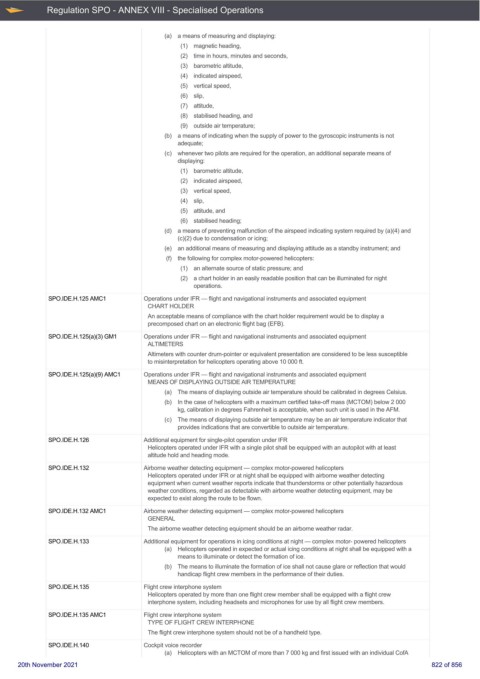Page 822 - UK Air Operations Regulations 201121
P. 822
~
~ Regulation SPO - ANNEX VIII - Specialised Operations Centrik
(a) a means of measuring and displaying:
(1) magnetic heading,
(2) time in hours, minutes and seconds,
(3) barometric altitude,
(4) indicated airspeed,
(5) vertical speed,
(6) slip,
(7) attitude,
(8) stabilised heading, and
(9) outside air temperature;
(b) a means of indicating when the supply of power to the gyroscopic instruments is not
adequate;
(c) whenever two pilots are required for the operation, an additional separate means of
displaying:
(1) barometric altitude,
(2) indicated airspeed,
(3) vertical speed,
(4) slip,
(5) attitude, and
(6) stabilised heading;
(d) a means of preventing malfunction of the airspeed indicating system required by (a)(4) and
(c)(2) due to condensation or icing;
(e) an additional means of measuring and displaying attitude as a standby instrument; and
(f) the following for complex motor-powered helicopters:
(1) an alternate source of static pressure; and
(2) a chart holder in an easily readable position that can be illuminated for night
operations.
SPO.IDE.H.125 AMC1 Operations under IFR — flight and navigational instruments and associated equipment
CHART HOLDER
An acceptable means of compliance with the chart holder requirement would be to display a
precomposed chart on an electronic flight bag (EFB).
SPO.IDE.H.125(a)(3) GM1 Operations under IFR — flight and navigational instruments and associated equipment
ALTIMETERS
Altimeters with counter drum-pointer or equivalent presentation are considered to be less susceptible
to misinterpretation for helicopters operating above 10 000 ft.
SPO.IDE.H.125(a)(9) AMC1 Operations under IFR — flight and navigational instruments and associated equipment
MEANS OF DISPLAYING OUTSIDE AIR TEMPERATURE
(a) The means of displaying outside air temperature should be calibrated in degrees Celsius.
(b) In the case of helicopters with a maximum certified take-off mass (MCTOM) below 2 000
kg, calibration in degrees Fahrenheit is acceptable, when such unit is used in the AFM.
(c) The means of displaying outside air temperature may be an air temperature indicator that
provides indications that are convertible to outside air temperature.
SPO.IDE.H.126 Additional equipment for single-pilot operation under IFR
Helicopters operated under IFR with a single pilot shall be equipped with an autopilot with at least
altitude hold and heading mode.
SPO.IDE.H.132 Airborne weather detecting equipment — complex motor-powered helicopters
Helicopters operated under IFR or at night shall be equipped with airborne weather detecting
equipment when current weather reports indicate that thunderstorms or other potentially hazardous
weather conditions, regarded as detectable with airborne weather detecting equipment, may be
expected to exist along the route to be flown.
SPO.IDE.H.132 AMC1 Airborne weather detecting equipment — complex motor-powered helicopters
GENERAL
The airborne weather detecting equipment should be an airborne weather radar.
SPO.IDE.H.133 Additional equipment for operations in icing conditions at night — complex motor- powered helicopters
(a) Helicopters operated in expected or actual icing conditions at night shall be equipped with a
means to illuminate or detect the formation of ice.
(b) The means to illuminate the formation of ice shall not cause glare or reflection that would
handicap flight crew members in the performance of their duties.
SPO.IDE.H.135 Flight crew interphone system
Helicopters operated by more than one flight crew member shall be equipped with a flight crew
interphone system, including headsets and microphones for use by all flight crew members.
SPO.IDE.H.135 AMC1 Flight crew interphone system
TYPE OF FLIGHT CREW INTERPHONE
The flight crew interphone system should not be of a handheld type.
SPO.IDE.H.140 Cockpit voice recorder
(a) Helicopters with an MCTOM of more than 7 000 kg and first issued with an individual CofA
20th November 2021 822 of 856

